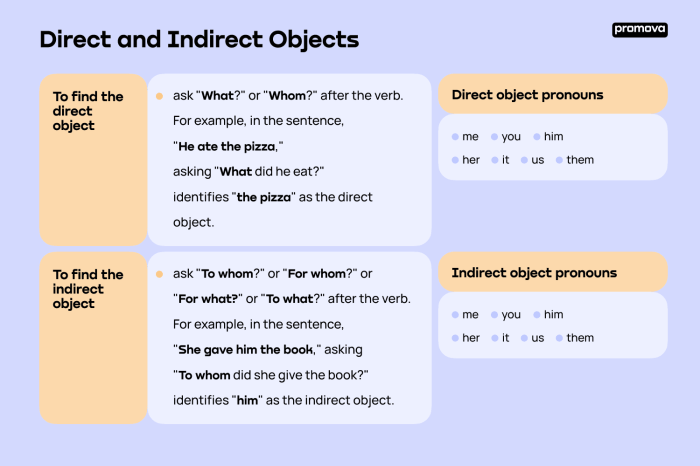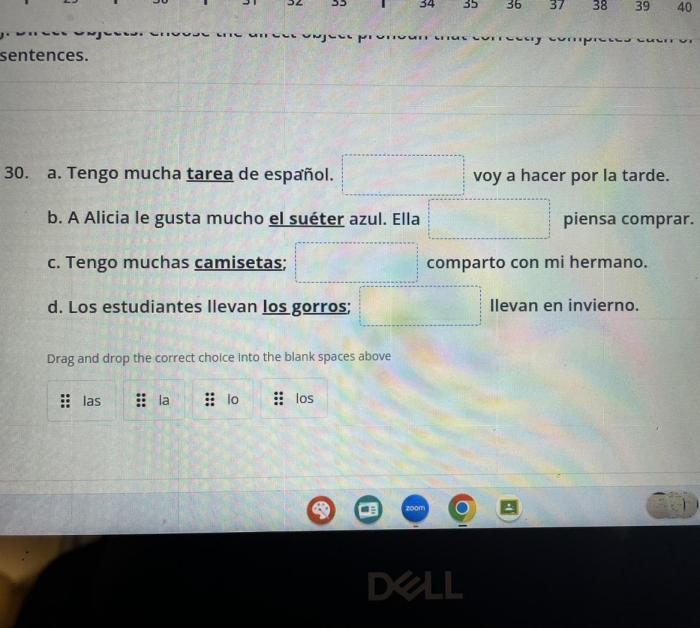Embarking on an exploration of which indirect object pronoun correctly completes the sentence, this discourse unveils the intricacies of grammar with precision and clarity. Indirect object pronouns play a pivotal role in conveying the intended meaning within a sentence, and this analysis delves into their usage, providing a comprehensive understanding of their function and application.
Delving into the grammatical landscape, we will define indirect object pronouns, examining their distinct characteristics and how they differ from direct object pronouns. Through illustrative examples and practical applications, we will uncover the rules governing their usage, ensuring a thorough grasp of this essential aspect of English grammar.
Indirect Object Pronouns: Which Indirect Object Pronoun Correctly Completes The Sentence

Indirect object pronouns are used to replace an indirect object in a sentence. An indirect object is a noun or pronoun that receives the direct object of a verb. For example, in the sentence “I gave the book to Mary,” “Mary” is the indirect object.
The indirect object pronoun for “Mary” is “her.”
Indirect object pronouns are used to make sentences more concise and to avoid repetition. They can also be used to emphasize the indirect object.
Examples of Indirect Object Pronouns
- me
- you
- him
- her
- it
- us
- you
- them
Grammatical Function of Indirect Object Pronouns
Indirect object pronouns function as objects of verbs. They are placed between the verb and the direct object. For example, in the sentence “I gave her the book,” “her” is the indirect object pronoun and “the book” is the direct object.
Identify the Correct Indirect Object Pronoun
Identify the correct indirect object pronoun to complete the sentence:
“I sent __________ the letter.”
The correct indirect object pronoun is “him.” The sentence should read: “I sent him the letter.”
The indirect object pronoun “him” is used because it replaces the indirect object “him.” The indirect object is the person or thing that receives the direct object of the verb. In this case, the direct object is “the letter” and the indirect object is “him.”
Demonstrate the Usage of Indirect Object Pronouns
| Subject | Verb | Direct Object | Indirect Object |
|---|---|---|---|
| I | gave | the book | to her |
| She | sent | the letter | to me |
| We | told | the story | to them |
In each of these sentences, the indirect object pronoun is used to replace the indirect object. This makes the sentences more concise and avoids repetition.
Differentiate Between Direct and Indirect Object Pronouns, Which indirect object pronoun correctly completes the sentence
Direct object pronouns are used to replace the direct object of a verb. Indirect object pronouns are used to replace the indirect object of a verb.
The following table shows the differences between direct and indirect object pronouns:
| Pronoun | Direct Object | Indirect Object |
|---|---|---|
| me | yes | no |
| you | yes | no |
| him | yes | no |
| her | yes | no |
| it | yes | no |
| us | yes | no |
| you | yes | no |
| them | yes | no |
| myself | yes | no |
| yourself | yes | no |
| himself | yes | no |
| herself | yes | no |
| itself | yes | no |
| ourselves | yes | no |
| yourselves | yes | no |
| themselves | yes | no |
Direct object pronouns are placed after the verb. Indirect object pronouns are placed between the verb and the direct object.
Top FAQs
What is an indirect object pronoun?
An indirect object pronoun is a word that replaces an indirect object, which is a noun or pronoun that receives the action of the verb but is not directly affected by it.
How do I identify an indirect object pronoun?
An indirect object pronoun typically comes before the direct object and answers the question “to whom” or “for whom.”
What are some examples of indirect object pronouns?
Some common indirect object pronouns include me, you, him, her, it, us, and them.


